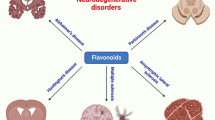Abstract
Due to the complex pathogenesis of AD, the multitarget-directed ligands (MTDLs) strategy presented the best pharmacological option for AD treatment. Herein, a series of novel 2-acetylphenol-O-alkylhydroxyethylamine derivatives (5a–f and 6a–f) was rationally designed and synthesized. Of these derivatives, 5c was a good multifunctional agent (eeAChE IC50 = 7.9 μM, MAO-B IC50 = 9.9 μM, BACE1 IC50 = 8.3 μM) in vitro and displayed a mixed-type AChE inhibition, which could bind to the CAS and PAS of AChE. Compound 5c also exhibited good antioxidant activity (ORAC = 2.5 eq) and neuroprotective effects. Furthermore, compound 5c was a selective metal ions chelator. And it could cross blood–brain barrier in vitro and complied with drug-like properties rule of 5. Therefore, compound 5c was a promising multifunctional agent for the treatment of AD.









Similar content being viewed by others
References
Barnett R. Alzheimer’s disease. Lancet. 2019;393:1589.
Patterson C. World Alzheimer Report 2018—the state of the art of dementia research: new frontiers. Alzheimer’s Disease International (ADI), London. 2018;1–48.
Alzheimer’s Disease International. 2019. World Alzheimer Report 2019: Attitudes to dementia. London: Alzheimer’s Disease International. London. 2019;1-166.
Wang YJ. Alzheimer disease: Lessons from immunotherapy for Alzheimer disease. Nat Rev Neurol. 2014;10:188–9.
Jagust W. Imaging the evolution and pathophysiology of Alzheimer disease. Nat Rev Neurosci. 2018;19:687–700.
Anand P, Singh B. A review on cholinesterase inhibitors for Alzheimer’s disease. Arch Pharm Res. 2013;36:375–99.
Greig NH, Utsuki T, Yu Q, Zhu X, Holloway HW, Perry T, et al. A new therapeutic target in Alzheimer’s disease treatment: attention to butyrylcholinesterase. Curr Med Res Opin. 2001;17:159–65.
Hardy J, Selkoe DJ. The amyloid hypothesis of Alzheimer’s disease: progress and problems on the road to therapeutics. Science. 2002;297:353–6.
Nalivaeva NN, Turner AJ. Targeting amyloid clearance in Alzheimer’s disease as a therapeutic strategy. Br J Pharm. 2019;176:3447–63.
Burki T. Alzheimer’s disease research: the future of BACE inhibitors. Lancet 2018;391:2486.
Kumar D, Ganeshpurkar A, Kumar D, Modi G, Gupta SK, Singh SK. Secretase inhibitors for the treatment of Alzheimer’s disease: Long road ahead. Eur J Med Chem. 2018;148:436–52.
Dixon SJ, Stockwell BR. The role of iron and reactive oxygen species in cell death. Nat Chem Biol. 2014;10:9–17.
Liu Y, Nguyen M, Robert A, Meunier B. Metal Ions in Alzheimer’s Disease: A Key Role or Not? Acc Chem Res. 2019;52:2026–35.
Wang L, Yin YL, Liu XZ, Shen P, Zheng YG, Lan XR, et al. Current understanding of metal ions in the pathogenesis of Alzheimer’s disease. Transl Neurodegener. 2020;9:10.
Schedin-Weiss S, Inoue M, Hromadkova L, Teranishi Y, Yamamoto NG, Wiehager B, et al. Monoamine oxidase B is elevated in Alzheimer disease neurons, is associated with γ-secretase and regulates neuronal amyloid β-peptide levels. Alzheimers Res Ther. 2017;9:57.
de Freitas Silva M, Dias KST, Gontijo VS, Ortiz CJC, Viegas C Jr. Multi-target directed drugs as a modern approach for drug design towards Alzheimer’s disease: An update. Curr Med Chem. 2018;25:3491–525.
Gezegen H, Gürdere MB, Dinçer A, Özbek O, Koçyiğit ÜM, Taslimi P, et al. Ceylan M. Synthesis, molecular docking, and biological activities of new cyanopyridine derivatives containing phenylurea. Arch Pharm. 2021;354:e2000334.
Cavalli A, Bolognesi ML, Minarini A, Rosini M, Tumiatti V, Recanatini M, et al. Multi-target-directed ligands to combat neurodegenerative diseases. J Med Chem. 2008;51:347–72.
Zhang P, Xu S, Zhu Z, Xu J. Multi-target design strategies for the improved treatment of Alzheimer’s disease. Eur J Med Chem. 2019;176:228–47.
Legoabe LJ, Petzer A, Petzer JP. 2-acetylphenol analogs as potent reversible monoamine oxidase inhibitors. Drug Des Devel Ther. 2015;9:3635–44.
Zhu G, Wang K, Shi J, Zhang P, Yang D, Fan X, et al. The development of 2-acetylphenol-donepezil hybrids as multifunctional agents for the treatment of Alzheimer’s disease. Bioorg Med Chem Lett. 2019;29:126625.
Sang Z, Wang K, Wang H, Wang H, Ma Q, Han X, et al. Liu W. Design, synthesis and biological evaluation of 2-acetyl-5-O-(amino-alkyl)phenol derivatives as multifunctional agents for the treatment of Alzheimer’s disease. Bioorg Med Chem Lett. 2017;27:5046–52.
Domínguez JL, Fernández-Nieto F, Castro M, Catto M, Paleo MR, Porto S, et al. Computer-aided structure-based design of multitarget leads for Alzheimer’s disease. J Chem Inf Model. 2015;55:135–48.
Sang Z, Qiang X, Li Y, Yuan W, Liu Q, Shi Y, et al. Deng Y. Design, synthesis and evaluation of scutellarein-O-alkylamines as multifunctional agents for the treatment of Alzheimer’s disease. Eur J Med Chem. 2015;94:348–66.
Rosenberry TL, Sonoda LK, Dekat SE, Cusack B, Johnson JL. Analysis of the reaction of carbachol with acetylcholinesterase using thioflavin T as a coupled fluorescence reporter. Biochemistry. 2008;47:13056–63.
Sang Z, Wang K, Shi J, Liu W, Cheng X, Zhu G, et al. The development of advanced structural framework as multi-target-directed ligands for the treatment of Alzheimer’s disease. Eur J Med Chem. 2020;192:112180.
Sang Z, Wang K, Shi J, Cheng X, Zhu G, Wei R, et al. Apigenin-rivastigmine hybrids as multi-target-directed liagnds for the treatment of Alzheimer’s disease. Eur J Med Chem. 2020;187:111958.
Sang Z, Wang K, Wang H, Wang H, Ma Q, Han X, et al. Liu W. Design, synthesis and biological evaluation of 2-acetyl-5-O-(amino-alkyl)phenol derivatives as multifunctional agents for the treatment of Alzheimer’s disease. Bioorg Med Chem Lett. 2017;27:5046–52.
Wang XL, Bian ZX, Wang XG. The IR spectra of complexes of N-(phenyl, ferrocenyl)methyl-beta-hydroxyethylamine with Ni(II), Cu(II), Zn(II), Cd(II) and Hg(II). Guang Pu Xue Yu Guang Pu Fen Xi. 2007;27:2221–3.
Sang Z, Wang K, Zhang P, Shi J, Liu W. Tan Z. Design, synthesis, in-silico and biological evaluation of novel chalcone derivatives as multi-function agents for the treatment of Alzheimer’s disease. Eur J Med Chem. 2019;180:238–52.
Zhao XJ, Gong DM, Jiang YR, Guo D, Zhu Y, Deng YC. Multipotent AChE and BACE-1 inhibitors for the treatment of Alzheimer’s disease: Design, synthesis and bio-analysis of 7-amino-1,4-dihydro-2H-isoquilin-3-one derivates. Eur J Med Chem. 2017;138:738–47.
Di L, Kerns EH, Fan K, McConnell OJ, Carter GT. High throughput artificial membrane permeability assay for blood-brain barrier. Eur J Med Chem. 2003;38:223–32.
Sang Z, Li Y, Qiang X, Xiao G, Liu Q, Tan Z, Deng Y. Multifunctional scutellarin-rivastigmine hybrids with cholinergic, antioxidant, biometal chelating and neuroprotective properties for the treatment of Alzheimer’s disease. Bioorg Med Chem. 2015;23(4):668-680.
Sang Z, Pan W, Wang K, Ma Q, Yu L, Liu W. Design, synthesis and biological evaluation of 3,4-dihydro-2(1H)-quinoline-O-alkylamine derivatives as new multipotent cholinesterase/monoamine oxidase inhibitors for the treatment of Alzheimer’s disease. Bioorg Med Chem. 2017;25(12):3006-3017.
Acknowledgements
This work was supported by funding from the Key Scientific Research Project of Colleges and Universities in Henan Province (NO.20A350006), and the Special Project of Nanyang Normal University (SYKF2020032, 2020QN036, and 2020QN045).
Author information
Authors and Affiliations
Corresponding authors
Ethics declarations
Conflict of interest
The authors declare no competing interests.
Additional information
Publisher’s note Springer Nature remains neutral with regard to jurisdictional claims in published maps and institutional affiliations.
Supplementary information
Rights and permissions
About this article
Cite this article
Zhu, G., Li, X., Yang, J. et al. Development of novel 2-acetylphenol-O-alkylhydroxyethylamine derivatives as multifunctional agents for Alzheimer’s disease treatment. Med Chem Res 30, 2016–2029 (2021). https://doi.org/10.1007/s00044-021-02786-7
Received:
Accepted:
Published:
Issue Date:
DOI: https://doi.org/10.1007/s00044-021-02786-7




